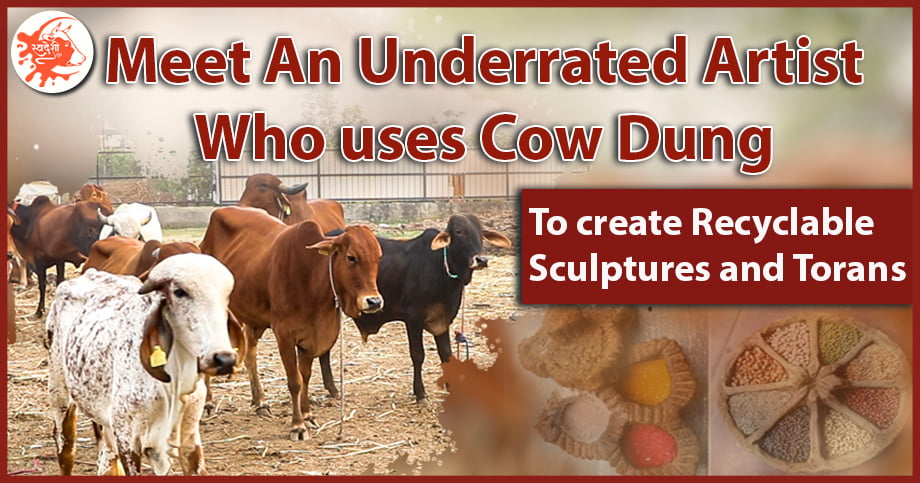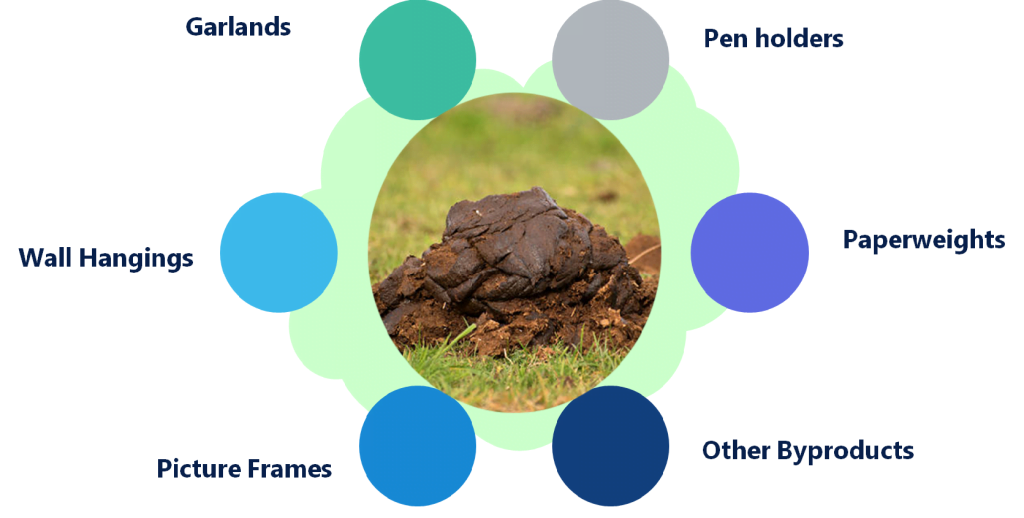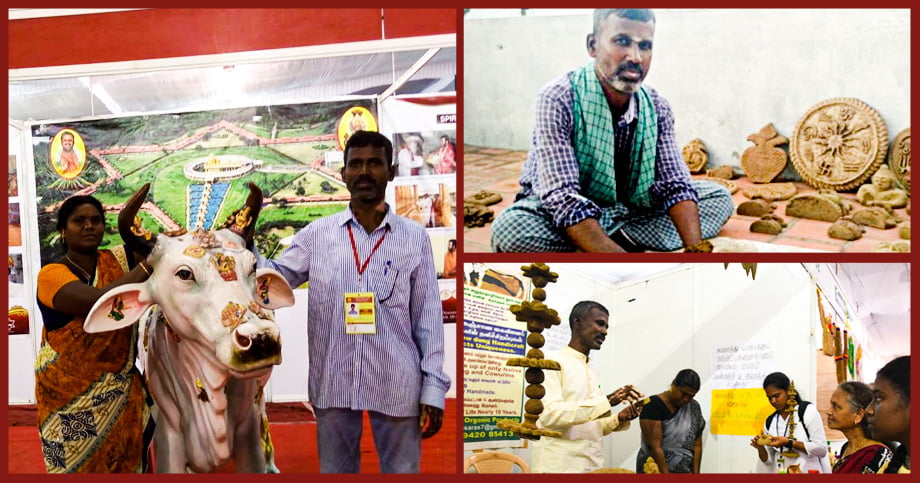
Imagine creating a stunning sculpture out of cow poo in Mahatma Gandhi’s honour as the nation’s father! There’s more; hold on. Made from cow dung and cow urine is a figure of Lord Ganesha with Lord Shiva and Mata Parvathi, Lord Shiva in a meditating state, a woman performing ‘aarti,’ and scenes honouring motherhood and childbirth. In this post, we’ll learn about P Ganesan, an organic farmer who has been creating sculptures out of cow dung and cow urine for the past five years. He crafts usable and ornamental products that can last up to ten years.
Besides yielding A2 milk, desi cows also yield Gobar, urine, etc. Cow dung(Gobar) served as a vital source of fuel, a building material, a purification, etc. In fact, our Vedas extensively cover the benefits of using cow dung and advise doing so. But regrettably, the use of cows and their byproducts has decreased significantly over time. Although there are many people advocating for sustainable living and emphasising the benefits of using the earth’s resources, their numbers are actually quite small. P. Ganesan is one such hero who advocates for and leads a “natural life.”
Though creating income from waste is a universal concept, few people really practise it. P. Ganesan, an organic farmer from Perungamanallur in the Peraiyur Taluk near Madurai, recognised the potential for profit from the excrement from the native cow breeds he raises. Mr. Ganesan has created more than 80 different products utilising cow dung and urine, ranging from garlands, wall hangings and to paperweights, pen holders, and picture frames. These items can last for at least eight years and are better for the environment than plastic products.

P Ganesan is an expert in all elements of agriculture and is from the Tamil Nadu village of Perungamanallur near Madurai. Around five years ago, he converted his nine-acre farm into an organically certified farm. Ganesan thinks that one of the most crucial elements in environmentally friendly farming is cow manure and cow urine. In order to obtain enough dung to produce organic fertilisers[1] like panchagavya and jeevamrutha, he purchased a few native breeds of cows when he switched to organic farming.
But to Ganesan’s amazement, he received considerably more cow dung than he needed for his farming. He then began to consider a different strategy for keeping it from going to waste. He quickly came up with a solution by creating artefacts solely from cow dung and cow urine. Ganesan has mastered this method during the past five years, making handicrafts in a very distinctive and natural way. He began by carving tiny Ganesha sculptures. Also, he currently produces more than 150 functional and decorative items. He even gets requests for customised orders from all throughout the state and occasionally from abroad.
Ganesan remembers as a child how his family would construct tiny Ganesha statues out of cow dung. Ganesan attended a training session just around the time he decided to switch to organic farming, where a student made suggestions for creative ways to use cow dung. The 60 idols he produced were rapidly sold out. Ganesan was inspired by this to advance his artistic abilities. Additionally, he began experimenting and gradually increased the diversity of his offerings. In the first year, he made about Rs 12,000 by selling the Ganesha statues. He was able to make Rs 25,000 the following year after adding a few new products and roughly Rs 75,000 the succeeding year.

P Ganesan produces each item using exclusively indigenous cows, whose dung and urine are used in the process. All of his cows are native breeds that are only given grass to eat and are allowed to graze freely on the land, which has an impact on the dung’s cleanliness and quality. He puts forth a lot of effort to produce such flawless artefacts that appear to be machine-made but are actually handmade. He exclusively shapes the objects using knives and needles. He insisted that he doesn’t take any action to get rid of the strong smell of cow dung that pervades the antiques.
By fiddling with a variety of incomplete plaques, lanterns, necklaces with beads, wall hangings, Kumkum jars, pen stands, fruit and spice holders, and intricately carved Swastik and Om signs, as well as a variety of other objects. He experimented with how his artefacts would respond to changes in time, place, and season. Over time, he also became more adept at using cow dung as a raw material. Except for the monsoon season, Mr P. Ganesan came to the conclusion that cow dung artwork may be perfectly created throughout the year. His abilities and initiatives are very remarkable. Around four years have passed since the artist started doing wonders out of cow excrement. Detailed statue of Buddha, a Hindu temple, wall decoration, symbolic sculptures like Om, and many more of his creations.
Fresh cow dung is used to produce each and every one of P Ganesan’s goods. Within 1-2 hours after the dung has been removed, the sculpture must be created. The product must then be dried in the sun for a number of days, depending on the thickness. The majority of the products are held on hand for at least 20 days before being shipped. He has developed a six-step procedure for perfecting the products. He only works during the months when it does not rain since the products must be dried outside in the sun. He currently creates around 100 different kinds of cow dung items. He is processing individual orders from different areas of Tamil Nadu and will eventually do the same for the entire nation.
A few years ago, J. Suresh Kannan, a businessman from Madurai, purchased a few items from Ganesan. He claimed he sold him a toran, a pen holder, and a Vinayagar idol about two years ago. They are still in excellent condition, and they haven’t noticed even a single surface crack since he purchased them. He claims that art is quite distinctive and that more appreciation is essential. The products have a price range that starts at Rs 5 and goes all the way up to Rs 3,000.
The fact that Ganesan cow dung artefacts are completely organic, environmentally beneficial, and even recyclable is their best quality. Even if the product is thrown away after a while, it will decompose into manure. It could also be reused and turned into an organic powder that can be sprinkled on plants after being diluted with water.
P Ganesan has created over 80 different products utilizing cow dung and urine, ranging from wall hangings to pen holders. These items can last for a minimum of eight years and are better for the environment than plastic things. P Ganesan has won numerous awards for his creative usage of cow dung and urine, including a certificate of congratulations from the Then district’s Krishi Vigyan Kendra unit, a government-run farmers’ welfare organisation. He started receiving special requests even from beyond the State as soon as the word spread. The sculptures and nameplates from Vinayagar, according to him, are the most highly prized goods. A six-foot-tall Buddha sculpture made from 30 kg of cow dung is the artist’s greatest masterpiece to date. Stay connected for more such interesting write-ups.
Read our Article: Throwing Light on the Benefits of Cow Dung and its Importance
